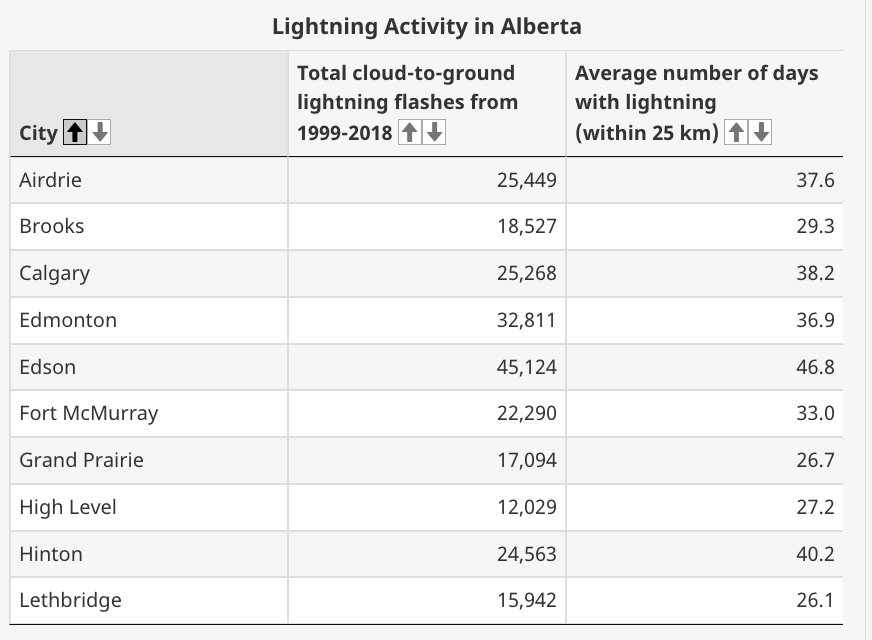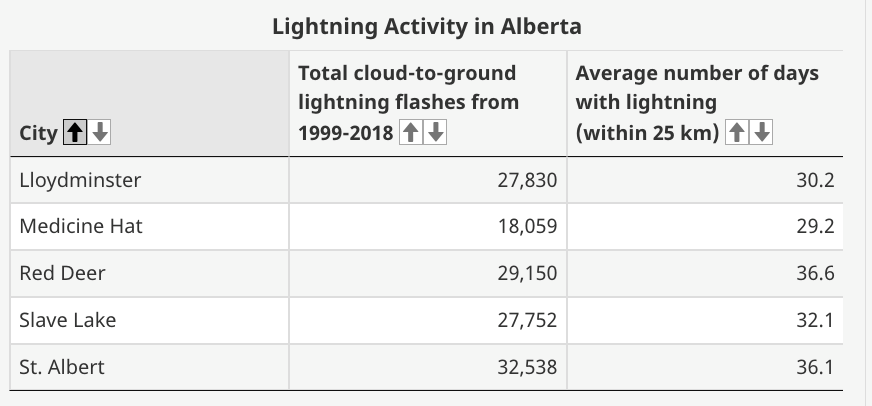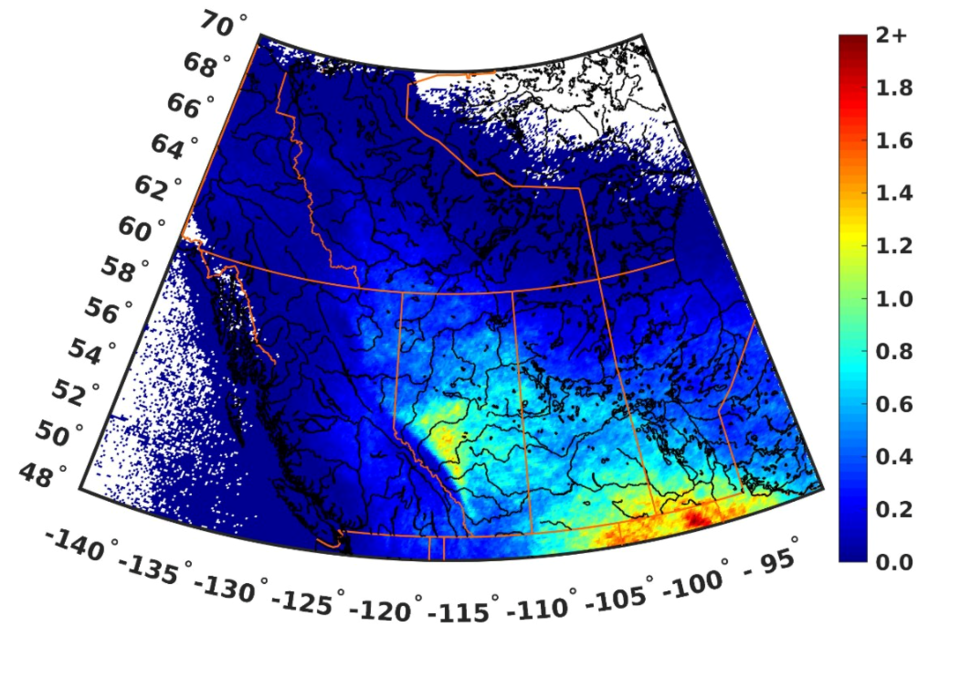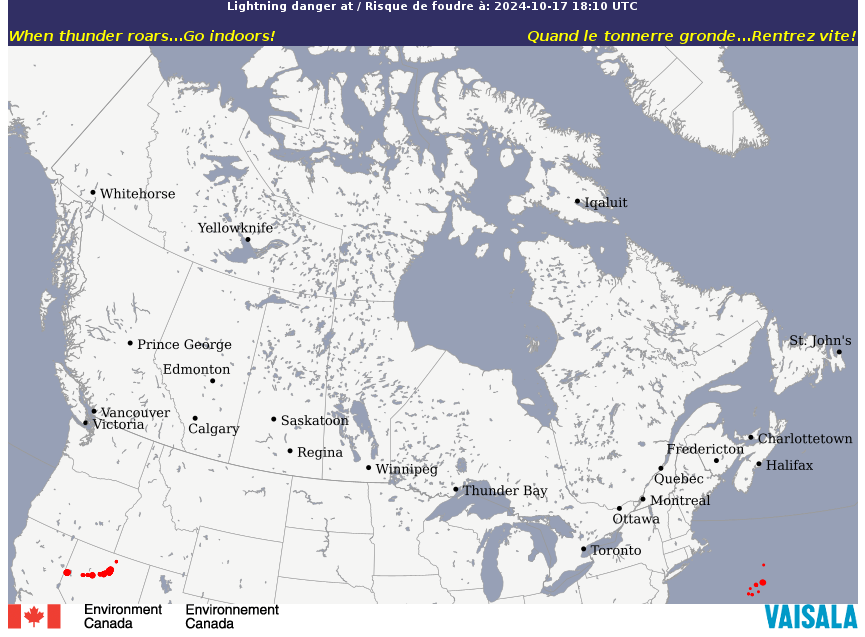The foothills of Alberta, which include Cochrane, rank among the highest for documented lightning strikes for communities in southern and central Alberta.
At 25,449 strikes per year recorded near Airdrie between 1999 and 2018, only the cities of St. Albert (32,358) and Edmonton (32,811) ranked higher. And all pale in comparison to the community of Edson which experienced 45,214 over the same time period. Calgary is very close to Airdrie with 25,268 documented strikes.


Source: Environment and Climate Change Canada Lightning in cities - Canada.ca
As to why the foothills, and the Calgary region in general, appear to be a geographical lightning rod, Environment and Climate Change Canada meteorologist and lightning expert Terri Lang says it has to do with the foothills. The mountains tend to disrupt the atmospheric conditions which allow thunderstorms to form, she explained, but what happens is as air pushes over the foothills is it appears to create the perfect breeding ground for storms and lightning formation.
“What often happens, especially close to the mountains, is there is an added component of the winds that forces the clouds more upwards and you tend to get more lightning strikes in the foothills before that air drifts off east,” Lang explained, pointing to Environment Canada’s Lightning Frequency Map and the big vivid yellow strike hot zone shown right over the region.
“It shows there is a big, enhanced area just from the foothills just to the east of there because of that added enhancement the winds bring as they interact with the foothills,” Lang confirmed.

Source: Environment and Climate Change Canada Lightning hotspots: map - Canada.ca
While these frequency statistics are drawn from a specific time period between 1999 and 2018, Lang said lightning strikes can now be confirmed in real time thanks to significant advances in lightning detection technology in Canada. Indeed, said Lang, Canada has one of the most advanced lightning strike detection networks in the world.
“There is a network of lightning detectors across Canada, and it is also built so it feeds off of NOAA in the States– they are part of the same network,” she explained. “The sensors are placed perfectly– they know how to maximize the distances between them. And so when a strike is detected, the system uses triangulation to place where the strike is. They are pretty amazing because this network processes millions of lightning strikes every year.”
That network can now detect lightning strikes nearly instantaneously, said Lang.
“We are able to determine when lightning has struck within seconds,” she stated. “Those lightning strikes can be detected to about within 100 metres. So if we get a report from a fire or police department, and there has been a house fire, and they are looking for a cause— often they just want to take lightning off the table as a cause. We can look and say, ‘Yeah, there were lightning strikes that night and here was the closest one.’ We can get them pretty darn close and the science and technology is pretty amazing.”
The ability to detect lightning as it occurs also gives fire services fighting wildfires, or trying to find potential wildfire outbreaks resulting from storms, great data to work with, said Lang.
“Of course, nobody knows where the lightning strikes are going to happen beforehand, but you can certainly narrow down the area where they occur,” Lang confirmed. “Those who manage forest fires are particularly interested in what they call dry lightning. That means thunderstorms that produce lightning, but very little rain.”
“We know the atmospheric conditions which produce dry lightning, and agencies like Alberta Forestry would use this to know and be ready– knowing there might be an area of dry lightning moving through. And the next day they would go out monitoring to see if there were any fire starts from the storms that went through.”
While the capability to detect and document lightning strikes is interesting and useful, Lang said the networks most important purpose is to raise public awareness and increase public safety.
“Lightning injures and kills more Canadians every year than tornadoes do, but tornadoes get all the press,” she said. “So the rule of thumb is when thunder roars, go indoors. If you can hear thunder or you can see lightning that means you are at risk of being struck by lightning."
In fact a full third of lightning strikes which harm people happen in the calm before the storm or just after it has passed, explained Lang.
“People think when it's raining– that’s when I’ll go inside,” stated Lang. “When, in fact, there have been documented cases of lightning travelling over 100 km from the cloud. So we call these bolts from the blue. This lightning comes ahead of the storm and it can squirt out the back too.”
The best place to enjoy the awe of a lightning storm is inside an enclosed dwelling or enclosed vehicle. Lang said it's a myth that rubber tires protect passengers from lightning strikes. Rather, it’s having the structure of the vehicle or home enclosed around you which allows lighting to pass around and into the ground.
“As Canadians, we love lightning storms,” Lang acknowledged. “People take out their lawn chair or whatever to go watch them, but we are always telling people to do it safely and that is inside a car or an enclosed building. Not in a gazebo. Not in a golf cart, nothing like that.”
To view Environment Canada’s live Lightning Danger Map visit https://weather.gc.ca/lightning/index_e.html



